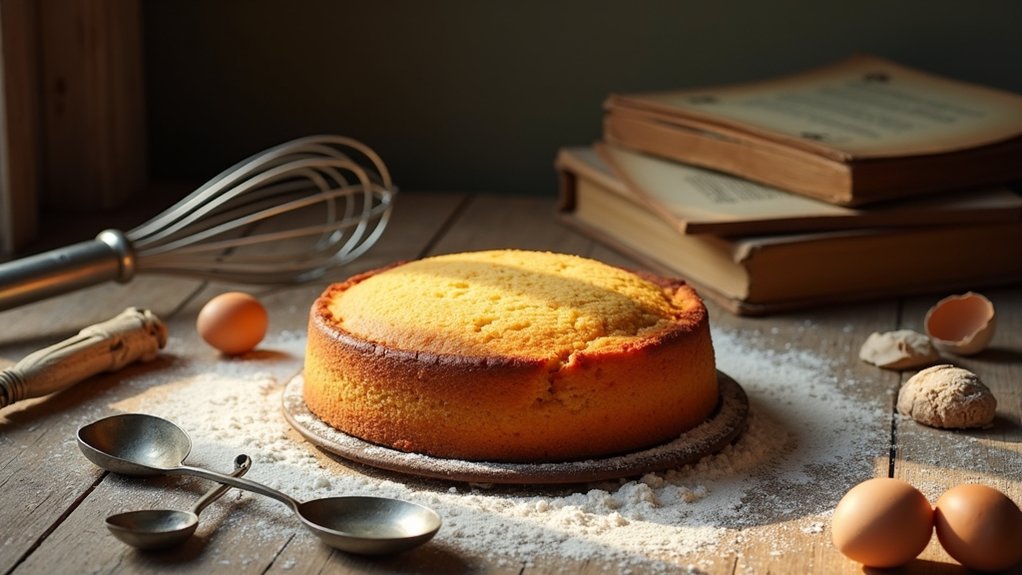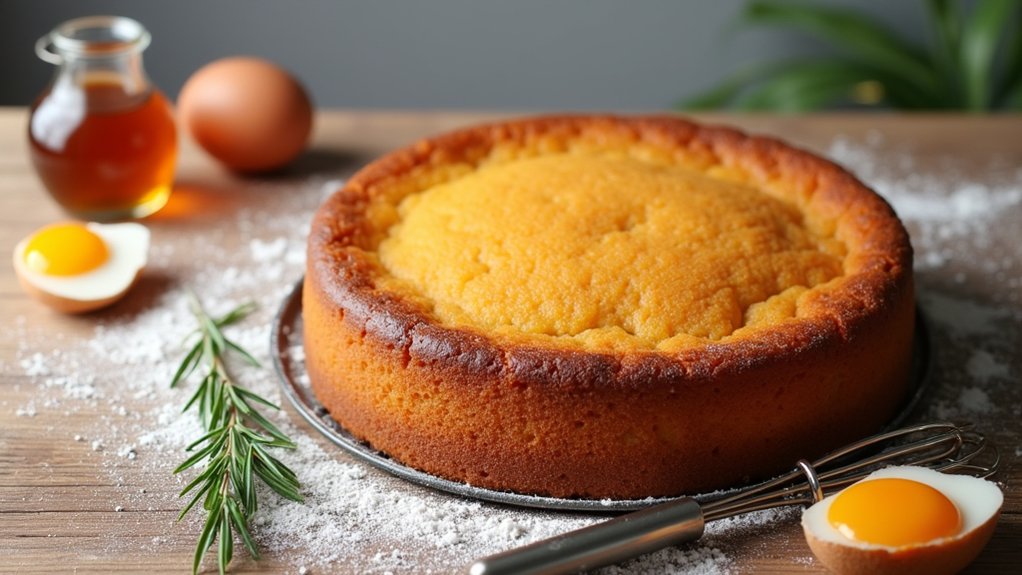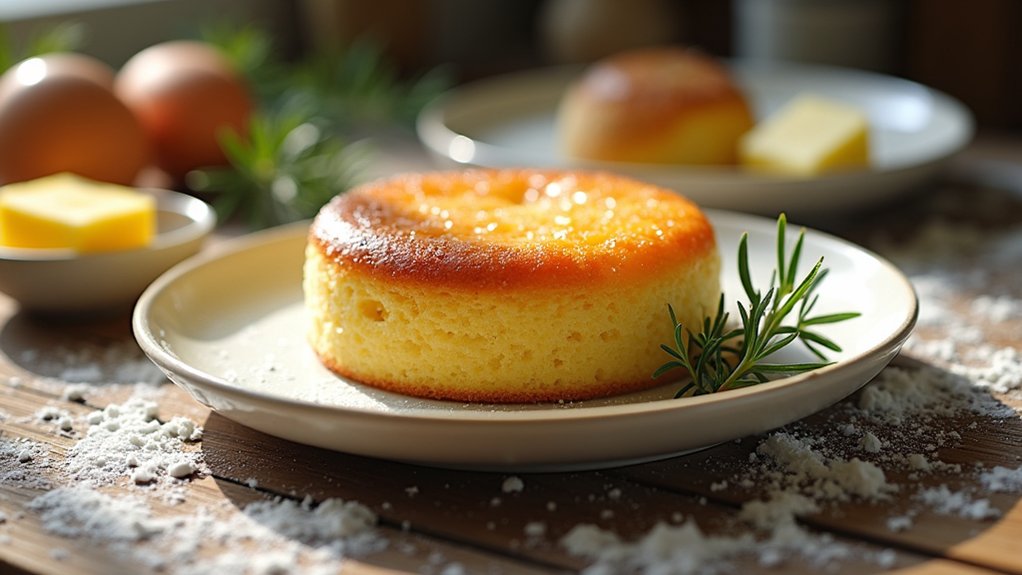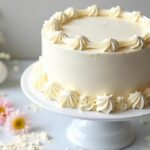Butter cake is a delightful treat that brings joy to any gathering with its rich, buttery flavor. To make it, you’ll need simple ingredients like butter, sugar, and eggs. Start by creaming butter and sugar, then add eggs gradually, sift in the flour, and mix well. The result is a moist cake perfect for any occasion. Each bite feels indulgent and nostalgic. If you stick around, I can share more tips to make this cake truly special!
Contents
History
When I think about butter cake, I can’t help but feel a wave of nostalgia wash over me, as this delightful treat has a rich history that many of us might not be aware of. Its cake origins can be traced back to the early days of baking traditions, where simple ingredients like butter, sugar, and flour were transformed into something extraordinary. This cake was a symbol of celebration, often enjoyed at family gatherings and special occasions. As baking evolved, so did the butter cake, embracing innovative techniques and flavors that keep it relevant today. The beauty of butter cake lies not only in its taste but also in how it connects generations, inviting us to share our own stories and experiences through each slice.
Recipe
Butter cake is a classic dessert that never fails to delight. Its rich, buttery flavor and tender crumb make it a favorite among many. This cake is perfect for any occasion, whether it’s a birthday party, an afternoon tea, or simply a sweet treat to enjoy at home. The simplicity of the ingredients and the ease of preparation make it an ideal recipe for both novice and experienced bakers alike.
To achieve the perfect butter cake, it’s important to use quality ingredients and pay attention to the mixing process. Creaming the butter and sugar together until light and fluffy is key to creating a light texture. Additionally, allowing the eggs to come to room temperature before adding them to the batter can make a significant difference in the outcome of your cake. With a few simple steps, you’ll have a delightful butter cake that can be enjoyed plain or dressed up with frosting, fresh fruit, or a dusting of powdered sugar.
Ingredients:
- 1 cup unsalted butter, softened
- 2 cups granulated sugar
- 4 large eggs, room temperature
- 3 cups all-purpose flour
- 1 tablespoon baking powder
- 1/2 teaspoon salt
- 1 cup whole milk
- 1 teaspoon vanilla extract
To make the butter cake, preheat your oven to 350°F (175°C). Grease and flour two 9-inch round cake pans. In a large mixing bowl, cream together the softened butter and granulated sugar until the mixture is light and fluffy. Add the eggs one at a time, mixing well after each addition. In a separate bowl, whisk together the flour, baking powder, and salt. Gradually add the dry ingredients to the wet mixture, alternating with the milk, and stir until just combined. Ultimately, mix in the vanilla extract. Divide the batter evenly between the prepared cake pans and bake for 25-30 minutes or until a toothpick inserted into the center comes out clean. Allow the cakes to cool in the pans for 10 minutes before transferring them to wire racks to cool completely.
For best results, verify your butter is at room temperature before starting, as this will help it cream better with the sugar. Experiment with different flavor additions, such as almond extract or lemon zest, to give your butter cake a unique twist. If you want a denser cake, consider reducing the milk slightly. In conclusion, the cooled cake can be stored in an airtight container for up to three days or frozen for later enjoyment. Enjoy your delicious homemade butter cake!
Cooking Steps
Now that we have our ingredients ready, let’s jump into the cooking steps that’ll bring our butter cake to life. First, I’ll preheat the oven to 350°F, so it’s nice and toasty when the batter’s ready. Then, I’ll mix the butter and sugar until it’s creamy, and you’ll see just how easy this delicious cake comes together!
Step 1. Preheat Oven to 350°F
Before diving into the delightful world of butter cake, let’s get our oven ready for action by preheating it to 350°F. This step is essential because the right oven temperature guarantees our cake bakes evenly, creating that tender, buttery texture we all crave. While the oven heats up, I take a moment to gather my ingredients and visualize the baking techniques I’ll be using. It’s all about precision and timing! Remember, an adequately preheated oven helps achieve that golden crust and fluffy interior. So, let’s set that timer and patiently wait a few minutes. Trust me, the anticipation only adds to the excitement of creating something delicious. Once it’s at 350°F, we’re ready to move on to the next step!
Step 2. Mix Butter and Sugar
With the oven all warmed up, it’s time to bring some magic to our mixing bowl by combining the butter and sugar. I love experimenting with different butter types—whether it’s creamy unsalted butter or even a rich European variety, they each add a unique flavor. I usually stick to granulated sugar, but don’t shy away from trying brown or even coconut sugar for a twist!
I grab my mixer and beat the butter until it’s fluffy, then gradually add the sugar, letting it blend until the mixture is light and airy. The aroma is simply delightful! This step is essential; it creates a tender cake that melts in your mouth. So, let’s get mixing and set the stage for our delicious butter cake!
Step 3. Add Eggs Gradually
As we plunge into the next step of our butter cake adventure, it’s time to introduce the eggs into our fluffy butter and sugar mixture. This is where the magic really begins! I like to crack each egg into a small bowl first, just to avoid any shell mishaps. Then, I add them one at a time, allowing for proper egg incorporation—this gradual addition helps create that lovely, airy texture we’re aiming for. After each egg, I mix just enough to blend it in before adding the next. It’s like building layers of flavor and richness, and trust me, your taste buds will thank you later. Let’s embrace this moment and watch our batter come alive!
Step 4. Sift in Dry Ingredients
Now that our eggy mixture is all set and ready, it’s time to sift in the dry ingredients, which will bring everything together for that perfect butter cake. I like to use a fine mesh sieve for sifting techniques; it helps aerate the flour, ensuring a light and fluffy texture. When measuring, I make sure to stick to precise dry ingredient ratios, as even a little variation can affect the cake’s structure. Gently sprinkle the flour mixture over the eggy base, making sure to sift it in slowly. This method allows the dry ingredients to blend seamlessly, creating a delightful batter that promises to be both tender and rich. Trust me, this step is essential for achieving cake perfection!
Step 5. Fold in Vanilla Extract
After our dry ingredients are perfectly blended into the eggy mixture, it’s time to add that wonderful touch of flavor: vanilla extract. I love using high-quality extract, as it truly elevates the vanilla flavor in our butter cake. With a gentle hand, I carefully fold in about a tablespoon of the extract, letting its rich aroma swirl through the batter. This step isn’t just about taste; it’s about creating that warm, nostalgic feeling we all cherish. Remember, the extract quality can make all the difference, transforming our cake from ordinary to extraordinary. As I mix, I feel excitement building, knowing this simple addition will enhance our cake’s charm. Let’s embrace this delightful moment and get ready for the next step!
Nutritional Guide
When it comes to enjoying a slice of butter cake, you might wonder about the nutritional aspects that come with it. While it’s a delightful treat, understanding its nutritional benefits can help you indulge wisely. If you’re looking for healthier options, ingredient substitutions can make a difference. Here’s a quick guide to the nutritional content of butter cake:
| Component | Traditional Recipe | Healthier Version |
|---|---|---|
| Calories | 350 | 250 |
| Sugar (g) | 30 | 15 |
| Fat (g) | 20 | 10 |
| Protein (g) | 5 | 7 |
Final Thoughts
Enjoying a slice of butter cake can be a delightful experience, especially when you consider the nutritional choices behind it. I’ve found that incorporating some simple baking tips can really elevate your cake. For instance, using quality butter and fresh eggs makes a noticeable difference in flavor! Don’t be afraid to experiment with flavor variations too; adding a splash of vanilla or a hint of lemon zest can transform your cake into something extraordinary. Whether you’re sharing it at a gathering or savoring it alone, each bite should feel special. So, gather your ingredients, release your creativity, and enjoy the process! Remember, baking is not just about the final product, but the joy of creating something delicious from scratch.
Frequently Asked Questions
Can I Substitute Butter With Margarine in This Recipe?
Yes, you can substitute margarine for butter. Just keep in mind that the margarine flavor might alter the taste slightly, and the texture differences could affect the final result. Experimenting can lead to delicious surprises!
How Long Can Butter Cake Be Stored?
A slice of heaven can last up to a week in an airtight container. For maximum cake freshness, I recommend refrigeration. Just remember, each day it sits, it loses a bit of that magic!
Can I Freeze Leftover Butter Cake?
Absolutely, I can freeze leftover cake! Using proper freezing techniques, I wrap it tightly in plastic and foil for ideal cake preservation. It’s a great way to enjoy a slice later without sacrificing flavor.
What Types of Frosting Pair Well With Butter Cake?
I love pairing butter cake with cream cheese frosting for a tangy twist or rich chocolate ganache for indulgence. Both options elevate the cake’s flavor, making it a delightful and innovative dessert experience.
How Can I Make a Gluten-Free Butter Cake?
To make a gluten-free butter cake, I use gluten-free flour and substitute dairy with almond milk or coconut yogurt. It’s a modern twist that keeps the cake delicious and moist, just like the classics!
Conclusion
As we wrap up our butter cake journey, think of this recipe as a warm hug on a plate, a sweet reminder of cherished moments shared with loved ones. Every bite captures the essence of home, inviting you to gather around the table and create your own memories. So go ahead, bake that cake, and let its buttery goodness fill your kitchen with joy. Trust me, your heart—and your taste buds—will thank you!










